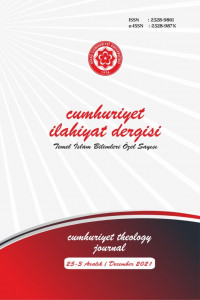Ulûmü’l-Hadîse Katkısı Bağlamında Müstahrec Türü Eserlerin Mahiyet
The Importance of Mustakhraj Works in the Context of Contribution to ʿUlūm al-Ḥadīth
Author(s): İsa OnaySubject(s): Semiotics / Semiology, Islam studies, Semantics, Philosophy of Religion, Hermeneutics
Published by: Cumhuriyet Üniversitesi İlahyat Fakültesi
Keywords: Ḥadīth; Isnād; Taḫrîc (Explanation); Mustakhraj; Abū ‘Awāna;
Summary/Abstract: The Muhaddis have demonstrated their efforts for the identification and preservation of ḥadīths by compiling various types of works such as musnad, mucem, sunen, musannef, cami‘. On the ṣaḥīḥs and Sunens in the golden age of classification, especially the works of Abū ʿAbdallāh Muḥammad b. Ismāʿīl al-Bukhārī (d. 256/870) and Ebu'l-Hüseyn Müslim b. al-Ḥad̲j̲d̲j̲ād̲j̲(d. 261/875) some studies have been done. Mustedrek, Mustakhraj, zawâid, aggregation, summary and commentary are studies on the main ḥadīth sources. From the third century on, in ḥadīth studies, it is seen that the works of the ḥadīths, which the ḥadīths gave importance to, have been dealt with depending on the subject of the authentic ḥadīth and some of their benefits have been explained. Based on the definitions in the method works, istihraj is the determination of the tariks of the narrations in a ḥadīth book by another scholar. The tariq and the producer he reached are sometimes combined with the sheikh of the author of the work, or with a sheikh who is higher up, sometimes even with a companion. In these works, expressions such as al-Muharrec, al-Musnad, es-Ṣaḥīḥ, es-Ṣaḥīḥu'l-Muharrec, al-Müsnedü's-ṣaḥīḥ and al-Müsnedü'l-Mustakhraj are sometimes used instead of the concept of mustahrec. The words "Mustakhrajat has a great value in the eyes of the people of ḥadīth" reveal its value in the eyes of ḥadīth scholars. Scholars valued the genre of mustahraj, which is thought to have contributed significantly to the science of ḥadīth, and they intensified their studies on Bukhari and Muslim, who are considered the basis of ḥadīth science (umdetu'l-ilm). According to the Muhaddis, in order to be able to pass judgment on any narration, it is necessary to have knowledge about the narration and its narrators. Considering the contributions it has made to the ʿulūm al-ḥadīth, to convey more than one narration on the same subject is an important issue. Because, in cases such as its determination, interpretation and preference, determining that the ḥadīth comes from different tariqs (chain) is accepted as a fact that strengthens the narration. The primary goal of the works of the mustahrec type is to obtain the ālī isnād, but it is seen that the copyrighted works contain a significant amount of abuses to the original text as well as to the individual texts. Considering that excess affect the ruling, it is considered important to focus on the mustakhraj type works, which contain different tariks, in terms of the discovery of the meaning and its contribution to the change of the ruling. In this study, an evaluation has been made about the nature of the mustakhraj, its benefits, the value of the mustakhraj as a species, their contribution to the ʿulūm al-ḥadīth in terms of promissory sanad and texts, and what they contain. In the research, the comparison of the narrations selected from the works of the mustakhraj type with the originals and whether the narrations in these works were used in the annotations were investigated. In the study, besides the ḥadīth method works, especially in determining the examples, due to the fact that it is one of the early period works and its reputation, Abū ‘Awāna Ya'kup al-Isferâyînî's (d. 316/929) “Musned ṣaḥīḥu'l-muharrec 'ala kitâbi Müslim” In the context of his work named, the concept of mustakhraj has been emphasized. As a result of the research, it can be said that being knowledgeable about the tariqs of the ḥadīths made important contributions to the sanad and text, and that the ḥadīthists referred to the tariqs in the aforementioned literature in the interpretation of the ḥadīth. In summary, in the context of narration and wisdom sciences such as gharib al-hadīth, ıkhtilaf al-hadīth, mushkil al-ḥadīth, ʿIlal al-ḥadīth, nâsiḫu’l-ḥadīth ve mensûḫuh, fiqh al-ḥadīth, it is seen that it makes significant contributions the determination and evaluation of the ḥadīth. Each item mentioned about the benefits of the works in question has a comprehensive study and research field in the science of ḥadīth. It can be said that the methods used/offered in the current researches in which studies on the holistic approach style are carried out are applied by the hadith scholars in the tradition of ḥadīth science (partly in the differences of isnad and commentaries). It is possible to say that the ḥadīthists refer to the tariks in the aforementioned literature in the interpretation of the ḥadīth. As a result of the research, it is understood that the narrations in the mustakhraj support the originals in terms of wording and meaning. In addition to the aim of increasing the prestige of the original, the differences in the isnad and texts show the necessity of evaluating the narrations independently of the original. This study on the mustakhraj shows that extensive research can be done on the place of the related literature in the ʿulūm al-ḥadīth.
Journal: Cumhuriyet İlahiyat Dergisi
- Issue Year: 25/2021
- Issue No: 3
- Page Range: 1319-1340
- Page Count: 22
- Language: Turkish

